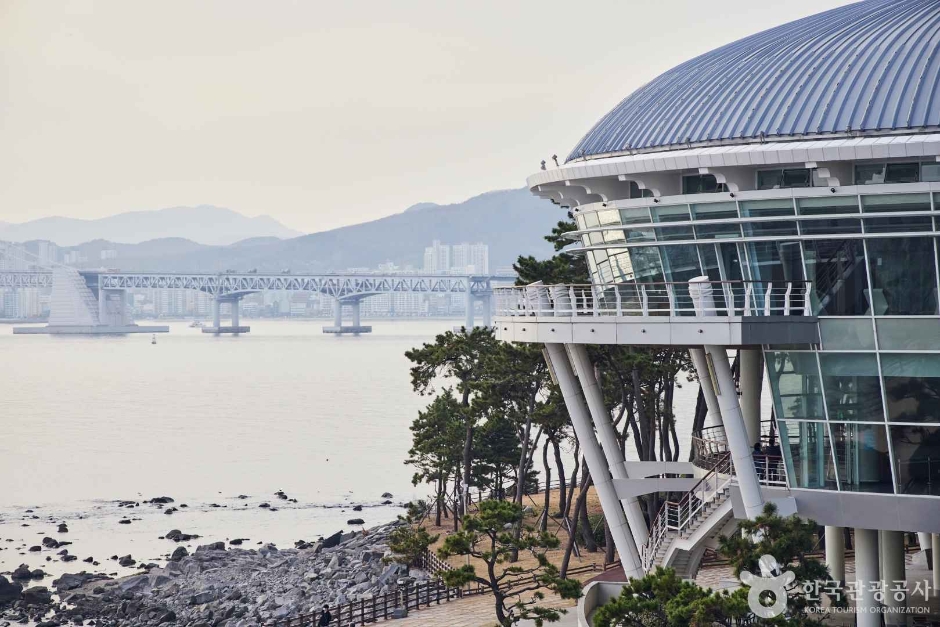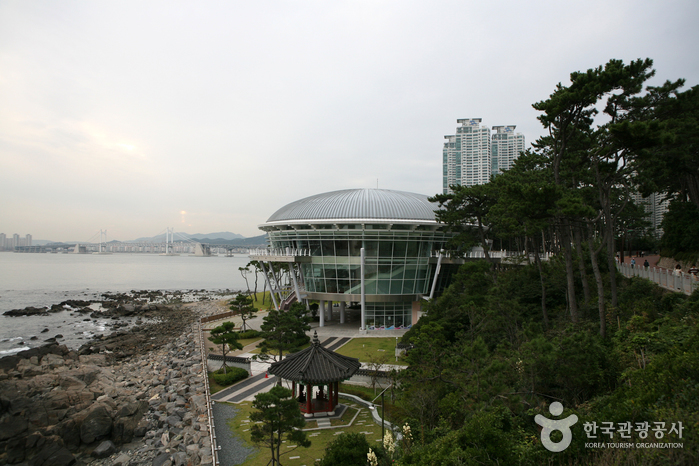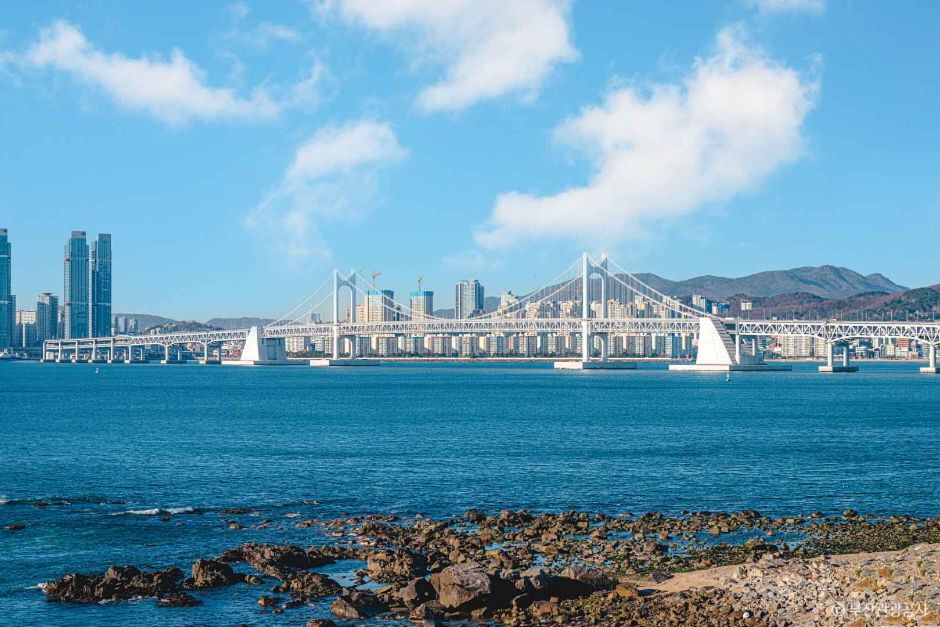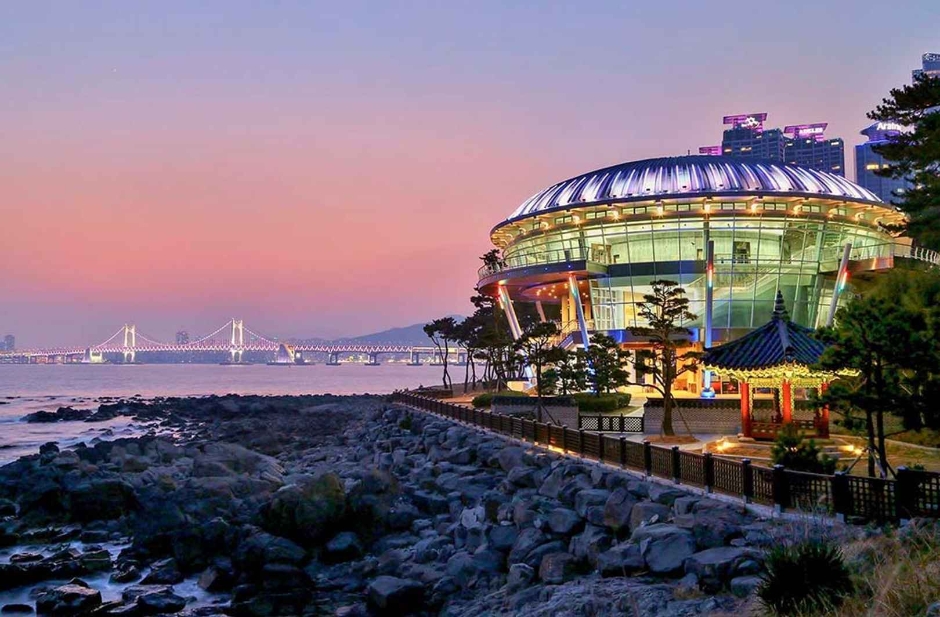Yeije Hanjeongsik (예이제 한정식)
16.2Km 2024-03-06
29, Haeundaehaebyeon-ro 298beon-gil, Haeundae-gu, Busan
+82-51-731-1100
Yeije Hanjeongsik offers hanjeongsik (Korean table d’hote) near Haeundae. It serves its Korean course menus, prepared with natural ingredients, in a charmingly luxurious and comfortable ambience. The dishes are plated to fine dining standards, so guests can have enjoyable dining experiences that also please in terms of visuals.
BUSAN X the SKY (부산엑스더스카이)
16.2Km 2025-04-15
30 Dalmaji-gil, Haeundae-gu, Busan
+82-51-731-0098
BUSAN X the SKY is the second highest building in Korea at 411.6 meters. Located at Haeundae LCT Landmark Tower, the largest observatory in Korea has both sea side and city view. Each floor provides a panoramic view of the landmarks of Busan as well as convenience facilities including lounge, X The Photo, gift shop and more.
Haeundae Dongbaekseom Island (해운대 동백섬)
16.2Km 2025-07-04
67 Dongbaek-ro, Haeundae-gu, Busan
+82-51-749-4072
Dongbaekseom Island (Island of Camellias) is an island located off one end of Busan's famous Haeundae Beach. Although the years of sedimentation have connected the island to the mainland, Dongbaekseom was originally an island and is still referred to as one.
Dongbaekseom Island is easy to navigate thanks to the walking path that is built around it. The island has several attractions, including the monument inscribed with a poem of scholar Choi Chi-won, the mermaid statue based on the legend of Princess Hwagok, and the Nurimaru APEC House. It also offers fantastic views of the Busan shoreline towards Mipo, Dalmaji Hill, Gwangangdaegyo Bridge, and Oryukdo Island. As the name suggests, camellias burst into bloom everywhere on the island from winter to spring.
Dongbaekseom Island (동백공원)
16.2Km 2021-12-17
U-dong, Haeundae-gu, Busan
+82-51-749-4491
Located near the south end of Haeundae Beach, Dongbaekseom Island was designated as a park in September 1, 1966. The island is full of dongbaek and pine trees and is connected to the main land by a bridge. The island also has a popular walking trail as well as badminton court, benches and restrooms.
Bunsanseong Fortress (김해 분산성)
16.2Km 2023-01-18
210-162, Gaya-ro 405beon-gil, Gimhae-si, Gyeongsangnam-do
+82-55-330-3925
Bunsanseong Fortress was constructed in the 3rd year of the reign of Goryeo's King U (1377) by Magistrate Park Wi to defend against foreign enemies, but it was destroyed during the Japanese invasion of 1592. The fortress we see today was reconstructed by Magistrate Jeong Hyeon-seok in the 8th year of the reign of Joseon's King Gojong (1871). However, it is estimated that it was first built during the days of Gaya. It is a temoe-style fortress with rocks piled up like a long band at the peak of Bunsan from which downtown Gimhae, Gimhae Plains, the Nakdonggang River and the South Sea are all in a single, panoramic view. Today, fortress walls remain stretching for some 900 meters on the slope towards the city and, inside the fortress, there are two gate sites in the south and north, an auxiliary gate on the west, a well site and several other building sites. The exact length of the remaining fortress walls is 929 meters and the average x_width is about 8 meters.
Inside the fortress lies Haeeunsa Temple, which was built to pay respects to Queen Heo of Garak who had come from the sea, according to stories. The temple also enshrines portraits of King Suro and Queen Heo that were painted during the Joseon dynasty. During the Japanese invasion of 1592, monk soldiers were stationed at this temple.
The fortress is more popularly called "Manjangdae" by Gimhae locals, and this name originated from the description, "A tall tower 10,000 (man) gil in x_height," granted by Daewongun in the Joseon dynasty for this advanced base that defeats Japanese invaders. A writing of "Manjangdae" written by Daewongun himself as well as his stamp are engraved on a rock behind a beacon that was restored in 1999.
Mega Mart - Gimhae Branch [Tax Refund Shop] (메가마트 김해점)
16.2Km 2024-04-22
20, Gimhae-daero 2492beon-gil, Gimhae-si, Gyeongsangnam-do
-
Olive Young - Namcheon Station Branch [Tax Refund Shop] (올리브영 남천역)
16.2Km 2024-04-18
384, Suyeong-ro, Suyeong-gu, Busan
-
Busan Gwangandaegyo Bridge (부산광안대교)
16.2Km 2025-04-15
203 Suyeonggangbyeon-daero, Haeundae-gu, Busan
+82-51-780-0077
Busan Gwangandaegyo Bridge (Busan 66, also called Gwangan-daero) stretches over 7.4 kilometers from Namcheon-dong in Suyeong-gu, Busan to Centum City in U-dong, Haeundae-gu. It is the longest bi-level bridge over the ocean in Korea. In addition to providing a quick way to get around, the bridge offers breathtaking views of nearby attractions, including the endlessly unfolding ocean, Oryukdo Island, Hwangnyeongsan Mountain, Gwangalli Beach, Dongbaekseom Island, and Dalmaji Hill.
Equipped with thousands of LED lights, the bridge showcases a beautiful lighting exhibition at night that changes with the seasons. The bridge offers a majesty beauty when combined with nearby attractions during the day and a romantic atmosphere at night, attracting many residents and tourists.
Olive Young - Busan Munhyeon Branch [Tax Refund Shop] (올리브영 부산문현점)
16.2Km 2024-06-27
1F, 31, Suyeong-ro, Nam-gu, Busan
-
Nurimaru APEC House (누리마루 APEC하우스)
16.3Km 2025-01-20
116 Dongbaek-ro, Haeundae-gu, Busan
Located on Dongbaekseom Island, an island of camellia trees, Nurimaru APEC House was the venue for the 2005 APEC Summit. Since then, it has been used as a memorial hall and a conference center. This three-story building is a contemporary recreation of a traditional Korean pavilion. The roof is inspired by the slope of Dongbaekseom Island, while the interior design features visual representations of traditional Korean culture. The terrace provides a great view of the Oryukdo Islets, Gwangandaegyo Bridge, and Dalmaji Hill. Visitors to Nurimaru APEC House can enjoy both the beauty of nature and the contemporary design of the building.




![Mega Mart - Gimhae Branch [Tax Refund Shop] (메가마트 김해점)](http://tong.visitkorea.or.kr/cms/resource/29/2885929_image2_1.jpg)
![Olive Young - Namcheon Station Branch [Tax Refund Shop] (올리브영 남천역)](http://tong.visitkorea.or.kr/cms/resource/18/2885718_image2_1.jpg)


 English
English
 한국어
한국어 日本語
日本語 中文(简体)
中文(简体) Deutsch
Deutsch Français
Français Español
Español Русский
Русский